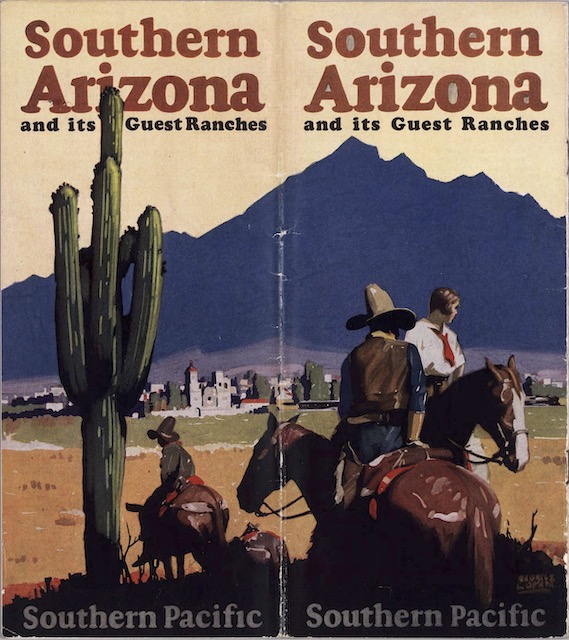When Southern Pacific built across southern Arizona in 1880, it went through Tuscon, not Phoenix. At the time, Tucson, with more than 7,000 people, was by far Arizona’s largest city, while Phoenix was a comparative village of 1,700 people.
 Click image to download a 18.0-MB PDF of this 16-page booklet, which is from the David Rumsey map collection.
Click image to download a 18.0-MB PDF of this 16-page booklet, which is from the David Rumsey map collection.
By 1920, Phoenix had surpassed Tucson and was the home of a growing number of resorts, but passengers to Phoenix had to get off the Southern Pacific at Maricopa and take an Arizona Eastern Railroad McKeen motor car 35 miles. To save its posh guests from this fate, in 1926 Southern Pacific spent $15 million (about $250 million in today’s money) building a new line from Wellton to Phoenix, allowing it to run its transcontinental trains through the state’s capital city. The new route was still about 43 miles longer than the old one, but (at least in 1929) the Sunset Limited, Golden State, and Californian used the new route while the Apache and Argonaut continued to use the shorter one.
This booklet was published in 1930 and prominently features the “New S.P.R.R.” line on the centerfold map, along with the old one. For good reason: of the 27 guest ranches described in the booklet, eleven were accessible via the new route, while none were on the old route. (The remainder were accessed via a part of the line that remained unchanged.)
According to the booklet, most of the guest ranches charged $40 to $65 per person per week; that’s about $700 to $1,200 in today’s money. That included food and usually including horseback riding. A few charged only $25 per week but that didn’t include food.
At least some of the guest ranches in this booklet, such as the Circle Z (which was “$60 a week and up”), still exist. The Circle Z’s rates today start at about $2,300 per person per week, so the 1927 rates were a comparative bargain.
The cover illustration shown above (which, of course, is on the back cover) is by Maurice Logan. His paintings grace similar Southern Pacific booklets for California, the Pacific Coast, and Mexico.
